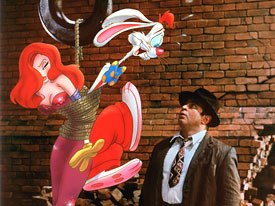This month in the Animated Scene, Joseph Gilland looks at the facing extinction of hand-drawn special effects animation.

A really big chunk of my animation career has been spent animating “special effects” in the old school meaning of the term. Hand-drawing things — water, smoke, fire, explosions, bubbles and pixie dust galore for over two decades. Learning was through trial and error and a great deal of drawing and study the classical way effects should be handled to ensure they were beautifully designed and elegantly animated with convincing physics. It is not an art form for dabblers. Animating hand-drawn effects well requires and an absolutely insane amount of labor, and the pencil mileage can get downright scary! There are no shortcuts to doing it well, no easy outs, especially if a director wants big scale special effects in his film, which most usually do.
Back in the late ‘80s and early ‘90s, working for Don Bluth in Los Angeles and in Ireland, special effects were thrown liberally at almost every single scene in a feature film. Don and his animation director/partner Gary Goldman just loved special effects. If a character was wearing glasses, or a medallion around his or her neck, they would have to have a glistening hi-light every time the character moved (à la The Secret of NIMH). If a character was holding a bottle or mug, or glass, or bucket, chances are it would have to be half-full of some sort of liquid, and slopping over the edges with every move, and of course the liquid should have hi-lights on it as well a transparency, and beneath the surface bubbles.

On the character animation side of things, the Roger Rabbit “look” which had become all the rage, required that every single scene in a feature film be lavishly lit with hi-lights, tones and shadows. Preferable with long cast shadows falling over complex background shapes over which they would have to conform to. This gut-wrenchingly unpleasant and repetitive task fell on the shoulders of the effects animators, who had spent their careers learning how to animate the magical elements, only to be relegated to the dull task of simply lighting character scenes.
In the back hallways of the effects department working on The Lion King the show was called the “Tone King” as every single character in every single scene was called upon to have tonal sculpting, added via painstakingly hand-drawn mattes, whether the shot called for dramatic lighting or not. It was an opulent look that Joe Public apparently demanded since seeing the characters so cleverly integrated with the live-action characters in Roger Rabbit. Not only was it a fairly big drag to draw this stuff, but every scene also became twice as time consuming, and, therefore, twice as costly to produce.
Another really difficult aspect of animating special effects was the handling what we call “props.” This could cover almost any object you could possibly conceive of, but the best way to define the objects that would be considered props to be handled by the effects department, was basically “anything that no other department wanted to do, or knew how to handle.”
While the character animators might handle a gun prop while it was being held by their character, if the character throws it, or drops it, or it gets blown up, chances are that the character animator would drop it like a hot potato and it would end up being drawn by the special effects crew. Doors or windows opening, vehicles, trees blowing in the wind, flower petals on a breeze, wagons, carts, lawnmowers, bicycles, axe grinders, snow shovels, water skis, ski boats, Spanish galleons — you name it — the effects department had to draw it. That was until the marvels of modern technology freed us, and we were quite suddenly given tools that enabled us to handle most of these “rigid body elements” using CGI techniques. Phew! What a relief.
But the path was riddled with roadblocks. Integrating 2D and 3D elements to make them look like they are drawn by the same artist, and painted with the same brush, is not an easy task. Conventional software was set up to do one thing or the other. To make the two techniques really integrate seamlessly took finesse and stroking. It was often difficult and prickly, rife with unexpected challenges and collaboration between artists and technical experts cut from a completely different cloth brought a whole new managerial twist to the traditional animation studio.
Take for instance the CGI clock tower workings of Disney’s The Great Mouse Detective. While it was quite marvelously well done, it did stand out, and the wheel and gears and cogs looked somehow “different” than all the other elements on the screen. But it did work, and it was hugely exciting. To have done scenes like this entirely by hand was unthinkable! We were entering in to a whole new dimension of animated possibilities. As the years went by and the traditional artists got more comfortable with the highly technical tools, and the technicians got used to the strange and temperamental artist folk they were expected to work with.
So here we are, a couple of decades later, and we’ve all survived the enormous upheavals of the animation industry. At least, I’m assuming you have if you are reading this. We’re all still here, animating our little butts off, whether on a light table or a PC, a toon’s a toon. We’re all stuck on this psychedelic cartoon trip together!
But somethings happening here that makes me a little nervous, when it comes to the incredible legacy of special effects animation, as opposed to the field of character animation. It has become, through the years, common knowledge that to become a great character animator, it is absolutely essential to learn the classical approach to animating. The importance of timing, exaggeration, stretch and squash, strong poses, anticipation, follow through and acting with a solid center of gravity in order to make a character believable is a well understood concept in the animation world today. More and more studios looking for 3D animators emphasize the classical animation skill set, as well they should.
Todays schools that offer 3D animation programs, generally devote a large portion of the early stages of their program to teaching a solid foundation of the classical hand-drawn approach to character animation. Those schools that dont emphasize it enough, turn out young artists who may know how to move things around, and have a fantastic understanding of the software package they are using, but their character animation will inevitably lack pizzazz and vitality. Acting performances suffer horribly without solid posing, center of gravity and dynamic timing. Happily, the trend is toward a deeper appreciation of what animation is really all about. Not just learning software, but a deeper knowledge of how things work.

But in the world of special effects, is this same emphasis being applied? I fear not. The field of visual effects, particularly in modern day education, has become almost entirely technical in nature. The emphasis is on software and technology, and the science behind it all, which is all good and fine, but hardly a mention is ever made of drawing, or the incredible history behind the evolution of effects animation. But I know for a fact, that the best visual effects animation we see in the industry today, are being created by artists with a solid background knowledge and curiosity about how things work!
I am not by any means not acknowledging the folks who are creating utterly fantastic special effects in the industry today. They are many, and there are many too, who approach it purely from a very technical aspect, but who are highly dedicated to understanding the physics behind things like fluid dynamics, fire, smoke, atmospherics, etc. and making them look and feel as good as possible.
But I am still seeing an enormous lack of dynamic range in the vast majority of high-end special effects I am seeing at the movie theater these days. Scientifically studying how these elements work in reality is great, but what of the classical principles of animation that we refer to when discussing character animation? Exaggeration? Posing? Dynamic timing? I am seeing more and more special effects animation that does not even begin to take advantage of the magical tricks in the classical animators toolbox. All too often the timing is constant and flat, lacking completely in any exaggeration.
Another enormously important aspect, which is sorely missing a great deal of the time, is the importance of the design principles that have been handed down to us through the ages by the original masters of the art of effects animation innovators like Ugo Dorsi, Cy Young, Jack Boyd, Josh Meador, and Dan McManus of the early Disney studios effects departments. These artists understood that the art of animation frees us to almost improve on nature, by pushing the dynamics of physics and design to their limits. Exaggerating the already magical elements of nature, they were able to take it a big step farther, exploding a vast array of effects visuals on the movie screen in Fantasia so long ago, with a mastery of the art form that hasnt been touched since.
The tools we have at our disposal today are utterly staggering. We can literally create anything on the screen today, and our imaginations are the only limitation. But it is way too easy to rely on these tools to do far too much of the work for us. We can create impressive eye candy without studying hard and learning from the past masters, and so more and more young artists today fail to do so. Particle effects simulations are fantastic to look at, even if you dont know how to exaggerate the design, and dynamic timing. But we are ripping ourselves off, if we do not pay homage to, and learn from, the folks who understood it best of all, long before most of us were born. Students flooding our schools often want to learn how to push the magic sexy effects button on their computers, and few of them are being made aware of the infinite world of magic that they should be delving into in the natural world around them, and the impressive legacy left to us by the original great effects animators of the '30s and '40s.

Its high time we remind ourselves in the animation industry today that, like classical animation or classical music, special effects animation as well, has a rich and exciting classical history. And that studying, observing and learning from that historical legacy, can provide a superior basis for a solid foundation to build on, for anyone who wants to be a part of the business of animating magic!
We owe it to each other, the viewing public (who may not notice the difference, but still deserve the best we can give them) and, in particular, the students of visual effects who want to do the best they can, but are not being made aware of the real tools available to them, beyond the pale of the cool glow of their computer screens.
In his 30-year animation career, Joseph Gilland has worked with studios as diverse Walt Disney Feature Animation and the National Film Board of Canada. He has worked on all styles of animation, experimental films, television series, commercials, theatrical feature films, stop motion, title sequences, live-action films and documentaries. He is currently the head of the classical and digital character animation programs at the Vancouver Film School, and writing a passionate book about the art of animation.







